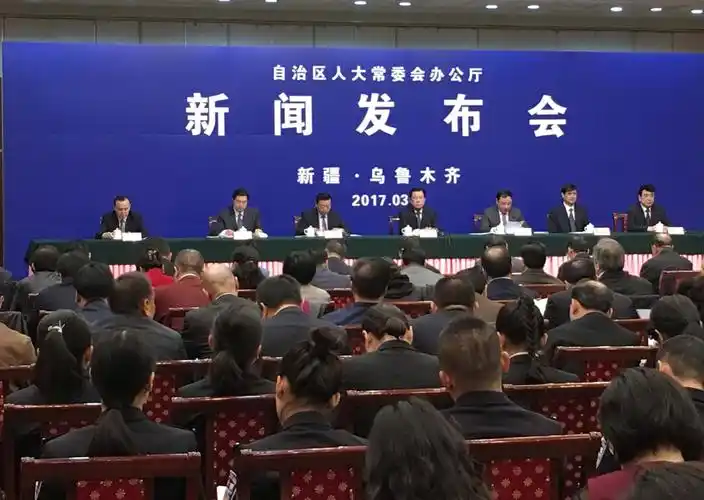
Prepared by Tahir Imin Uyghurian
Basic Information
- Name (English): Xinjiang Uyghur Autonomous Region De-Extremification Regulations
- Name (Chinese): 《新疆维吾尔自治区去极端化条例》
- Name (Uyghur, Latin script): “Shinjang Uyghur Aptonom Rayoni Ekstremizmdin Qutulush Nizami”
- Name (Turkish): “Sincan Uygur Özerk Bölgesi Aşırılıkla Mücadele Yönetmeliği”
- Name (Arabic): لائحة إزالة التطرف في منطقة شينجيانغ الويغورية ذاتية الحكم
- Issuing Body: Xinjiang Uyghur Autonomous Region People’s Congress Standing Committee (新疆维吾尔自治区人大常委会)
- Date of Passage: March 30, 2017 (12th Standing Committee, 28th meeting)
- Effective Date: April 1, 2017
- First Reported by: 央广网 (China National Radio Online), March 30, 2017
- Occasion of Announcement: News conference held by the General Office of the Xinjiang People’s Congress Standing Committee (新疆维吾尔自治区人大常委会办公厅召开新闻发布会)

Key Officials’ Statements
乃依木·亚森 (Nayim Yasin / Nayim Yasen)
- Position: Chairman of the Standing Committee of Xinjiang People’s Congress (自治区人大常委会主任)
- Main Points:
- Emphasized the significance of the regulation as Xinjiang’s first local law on de-extremification.
- Said it places de-extremification work into the track of legalization, standardization, and normalization.
- Claimed it ensures stronger guarantees to advance the policy and implements the central government’s directives, especially Xi Jinping’s instructions.
- Called the regulation a product of democracy and consensus-building.
- Ordered government agencies at all levels to quickly study, promote, and implement the regulation.
- Instructed the regional government to formulate detailed rules and measures for enforcement.
肖开提·依明 (Shohrat Zakir’s ally: Xiao Kaitı Yiming / Shohrat Imin)
- Position: Xinjiang Communist Party Standing Committee Member, Head of United Front Work Department (自治区党委常委、统战部部长)
- Main Points:
- Explained the regulation was formulated based on China’s existing laws and Xinjiang’s practical experiences in de-extremification.
- Stressed it has comprehensive content, clear structure, and strong operability, providing a legal basis for future measures.
- Claimed it raises the rule-of-law level of de-extremification efforts.
- Urged all levels of government and institutions to:
- Recognize the importance of de-extremification.
- Strengthen responsibility and urgency.
- Strictly study, publicize, and implement the regulation.
- Ensure it achieves practical results for the long-term stability (社会稳定和长治久安).
Core Content of the Regulation
The 条例 (Regulations), passed in March 2017 and effective April 1, 2017, provided legal grounds for many of the social and religious restrictions later reported in Xinjiang.
1. Definition of “Extremification”
- Defined broadly to include any ideology, speech, or behavior said to “incite hatred, violence, or religious fanaticism.”
- Essentially equated many religious and cultural practices with “extremism.”
2. Prohibited Behaviors and Practices
The regulation listed examples of “extremist manifestations” (极端化表现), which were banned by law, such as:
- Dress & Appearance
- Wearing face veils, burqas, or clothing with extremist symbols.
- “Abnormal” beards considered signs of extremism.
- Religion in Public Life
- Rejecting public broadcasting, watching/listening to state radio or TV.
- Refusing to comply with family planning (birth control) policies “due to extremism.”
- Rejecting state education or promoting “religious interference” in schools.
- Encouraging religious weddings or funerals outside official channels.
- Everyday Restrictions
- Naming children with “extremist” or “religious” names.
- Opposing singing, dancing, or other cultural activities deemed “normal.”
- Damaging state-issued ID documents or currency “with religious pretexts.”
- Using religion to interfere in social, political, or judicial affairs.
3. Government Responsibilities
- Required all levels of government (乡镇、街道、村、社区) to:
- Establish “de-extremification responsibility systems.”
- Implement education campaigns, propaganda, and vocational training.
- Ensure schools, media, and workplaces promote “modern, civilized lifestyles.”
4. Education and Propaganda
- Ordered the use of:
- Public media campaigns.
- Cultural and sports activities.
- Vocational education and training programs.
- Later these clauses were used to justify the establishment of “vocational education and training centers” (re-education camps).
5. Punishments and Enforcement
- Violations could lead to:
- Administrative penalties (fines, detentions).
- Criminal charges for serious cases.
- Officials failing to enforce the regulations could also be punished.
Key Takeaway
This regulation:
- Was the first local law in Xinjiang targeting so-called extremism, but in practice it criminalized ordinary Uyghur religious and cultural practices.
- Provided the legal basis for re-education camps, bans on Islamic dress, beards, religious naming, and restrictions on education.
- Was framed as part of the “依法治疆” (rule of law in governing Xinjiang) strategy under Xi Jinping.